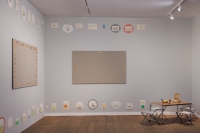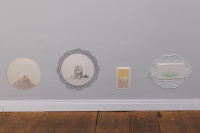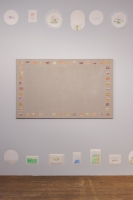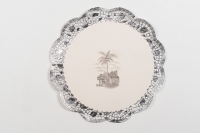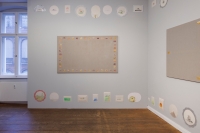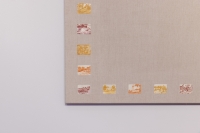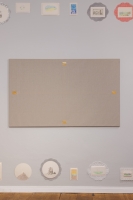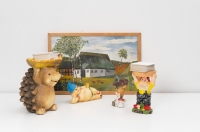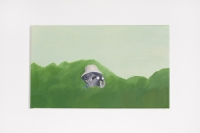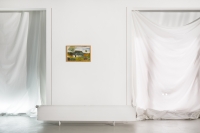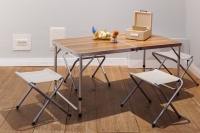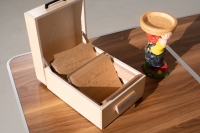After This…
2 Paintings, Acrylic on Linen 110x180 CM. , 32 Drawings on snack plates, 2 Garden Figures from Bianka and Adrian, 82 Writings on cards in 3 languages ( Thai, English, German) in Index wooden box, Folding Suitcase Table with 4 Stools.After This... (2022) is an installation by Orawan Arunrak. In this work, she questions the different levels of time and place that accumulate in the idea of a home. Her starting point is everyday objects that she finds in her immediate surroundings. Dwarf, hedgehog and landscape painting depict images of domesticity that breaks free from its own contexts and enters into new relationships. Fragments of stories can be read in the index box. They refer to places in different languages that seem very concrete – but only come to life through the imagination of their readers. They are about the invisible, sometimes fragmentary connections that are made through community and migration. They not only point to the voids that are not mentioned in any idea of “home”, but also open up possibilities for continuing to spin one’s own journey with them.
Text: Agnieszka Roguski
By using ordinary objects and simple mediums, Orawan Arunrak plays with our expectations and perceptions of the familiar and unfamiliar in relation to our surroundings. Snack plates serve as material for small drawings, depicting landscapes from unremarkable places. At first glance, Arunrak’s large paintings may seem empty, but upon closer inspection, delicate miniature drawings become apparent. They resemble brown road signs that indicate the presence of a touristic or historical site nearby but out of sight; however, in Arunrak’s work, they point to ordinary places of daily life. The installation is accompanied by cards with single words or sentences in Thai, English, and German, based on her observations of these landscapes. They form an associative map, offering a way to freely connect images and words, allowing smaller narratives to emerge within larger ones, linked to the viewer’s own experiences.
Text: Léon Kruijswijk
The installation After this... by Orawan Arunrak borrows landscape depictions from everyday life: from product packaging to signs for sights on the highway. For the motifs of the sepia-brown miniatures, the artist took photos with her cell phone of places in Thailand, Germany, and Vietnam, which, however, are not distinguished as special sights but are quite ordinary, and calls them "missing places." In her installation, Arunrak plays with our expectations, with the parameters of movement, distance and proximity. Many of the motifs seem familiar.
Text:Theresa Kampmeier
